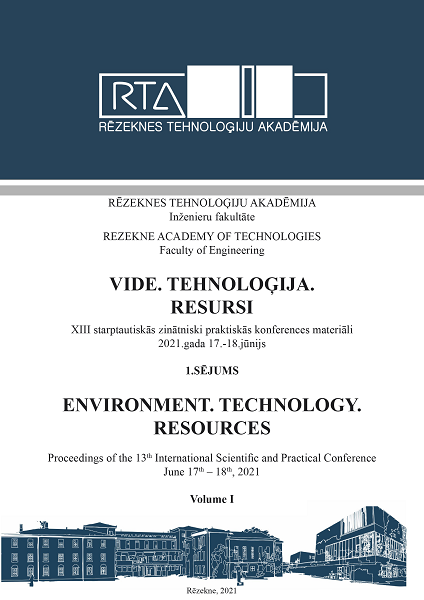INFLUENCE OF TEMPERATURE ON METHANE OUTPUT FROM BOG SLUDGE AND CRUSHED REED RAW MATERIALS
DOI:
https://doi.org/10.17770/etr2021vol1.6637Keywords:
Anaerobic fermentation, biogas, influence of temperatureAbstract
The research summarizes information on biochemical processes of biogas production and the parameters that affect the results of its production. The research examines the result of obtaining biogas from bog sludge and a mixture of crushed reed. Particular attention is given to temperature, as a parameter that affects the results of methane and biogas production.
The yield of biogas and methane during the bioprocess depends on the effect of temperature. During the experiment, 2.78 L of biogas with an average methane content of 38.7% was obtained from a mixture of bog sludge and crushed reeds. If the content of organic compounds in the sludge was higher, the biogas yield would increase during the process. It is more advantageous to use the raw material mixture for biogas production.
Downloads
References
S. Bhardwaj and P. Das, “A Review: Advantages and Disadvantages of Biogas” International Research Journal of Engineering and Technology, vol. 4 (10), pp. 890-893, October 2017. Available: IRJET, https://www.irjet.net/archives/V4/i10/IRJET-V4I10155.pdf [Accessed: March 31, 2021].
“Akvakultūras daudzgadu stratēģiskās pamatnostādnes 2014.–2020. gadam”, 2013. [Online]. Available: https://www.zm.gov.lv/public/files/CMS_Static_Page_Doc/00/00/00/35/82/akvakultura_2014.pdf [Accessed: March 31, 2021].
A. Kalniņš, “Biogāzes iespējas un tās kā transportlīdzekļu degvielas izmantošana”, 2007. [Online]. Available: http://petijumi.mk.gov.lv/sites/default/files/file/EM_Biogazes_iespejas_un_tas_ka_transportlidz_degv_izmantos_2007.pdf [Accessed: March 31, 2021].
Z. Bagi, N. Ács, T. Böjti, B. Kakuk, G. Rákhely, O. Strang, M. Szuhaj, R. Wirth and K. L. Kovács, “Biomethane: The energy storage, platform chemical and greenhouse gas mitigation target” Anaerobe, vol. 46, pp 13-22, August 2017. Available: ScienceDirect, https://www.sciencedirect.com/ [Accessed: March 31, 2021], https://doi.org/10.1016/j.anaerobe.2017.03.001
S. Mirmohamadsadeghi, K. Karimi, M. Tabatabaei and M. Aghbashlo, “Biogas production from food wastes: A review on recent developments and future perspectives” Bioresource Technology Reports, vol. 7, 100202, September 2019. Available: ScienceDirect, https://www.sciencedirect.com/ [Accessed: March 31, 2021], https://doi.org/10.1016/j.biteb.2019.100202
P. Wang, H. Wang, Y. Qiu, L. Ren and B. Jiang, “Microbial characteristics in anaerobic digestion process of food waste for methane production–A review” Bioresource Technology, vol. 248 (Part A), pp. 29-36, January 2018. Available: ScienceDirect, https://www.sciencedirect.com/ [Accessed: March 31, 2021], https://doi.org/10.1016/j.biortech.2017.06.152
Y. Hu, T. Kobayashi, W. Qi, H. Oshibe and K. Xu, “Effect of temperature and organic loading rate on siphon-driven self-agitated anaerobic digestion performance for food waste treatment” Waste Management, vol. 74, pp. 150-157, April 2018. Available: ScienceDirect, https://www.sciencedirect.com/ [Accessed: March 31, 2021], https://doi.org/10.1016/j.wasman.2017.12.016
S. K. Pramanik, F. B. Suja, S.M. Zain and B.K. Pramanik, “The anaerobic digestion process of biogas production from food waste: Prospects and constraints” Bioresource Technology Reports, vol. 8, 100310, December 2019. Available: ScienceDirect, https://www.sciencedirect.com/ [Accessed: March 31, 2021], https://doi.org/10.1016/j.biteb.2019.100310
S. Achinas and G. J. W. Euverink, “Theoretical analysis of biogas potential prediction from agricultural waste” Resource-Efficient Technologies, vol. 2, pp. 143-147, September 2016. Available: ScienceDirect, https://www.sciencedirect.com/ [Accessed: March 31, 2021], https://doi.org/10.1016/j.reffit.2016.08.001
J. Kainthola, A. S. Kalamdhad and V. V. Goud, “A review on enhanced biogas production from anaerobic digestion of lignocellulosic biomass by different enhancement techniques” Process Biochemistry, vol. 84, pp. 81-90, September 2019. Available: ScienceDirect, https://www.sciencedirect.com/ [Accessed: March 31, 2021], https://doi.org/10.1016/j.procbio.2019.05.023
T. Getahun, M. Gebrehiwot, A. Ambelu, T. Van Gerven and B. Van Der Bruggen, B, “The potential of biogas production from municipal solid waste in a tropical climate” Environmental Monitoring and Assessment, vol.186 (7), pp. 4637-4646, July 2014. Available: SpringerLink, https://link.springer.com/ [Accessed: March 31, 2021], https://doi.org/10.1007/s10661-014-3727-4


